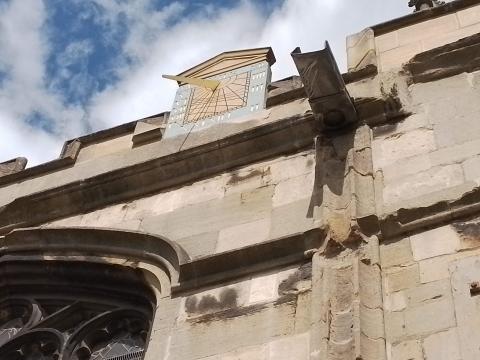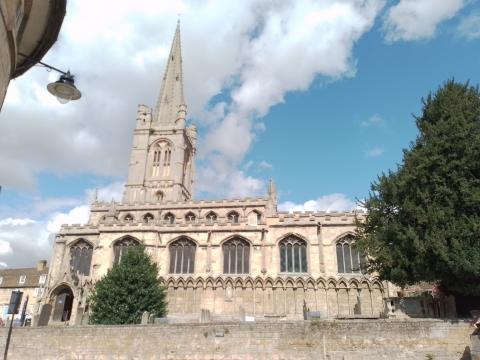Date Dials

This sundial was erected on the southern parapet of the church of All Saints’, Stamford, at the end of the seventeenth century or early in the eighteenth century. It was certainly in place by 1727, because it can be seen in the drawing of All Saints' Church included in Francis Peck's Antiquarian Annals of Stanford. The sundial was removed from the parapet in 2013, and taken for conservation. Nearly 300 years of surface erosion had rendered the face of the dial largely illegible. The original design was only visible in strong light. It is widely known that a sundial measures the time of day. It is less well-known that it can also measure the date. It does this by means of declination curves.
Examination of the gnomon shows a w-shaped notch on the upper edge called the nodus. Every day the shadow of the nodus traced a path across the face of the dial. These paths are called declination curves. Even though the stone is heavily eroded, several declination curves can be seen. We cannot be certain which dates these were intended to mark but it is probable that the first one marked the winter solstice (observed on 21st December), the shortest day in the northern hemisphere. The seventh one probably marked the summer solstice (21st June), the longest day in the northern hemisphere. The fourth line may mark the equinoxes - the two days in the year when day and night are of equal length (around 23rd September and 20th March). With the exception of the two solstices, all declination curves mark two dates- one when the sun is southbound the other when it is northbound. Thus a declination curve cannot claim to mark a unique date, but a pair of dates. The second, third, fifth and sixth declination curves probably mark 20th January; 18th February; 20th April and 21st May when the sun is northbound. Correspondingly, the sixth, fifth, third and second curves probably mark 23rd July; 23rd August; 23rd October and 22nd November when the sun is southbound. The declination curves in this case are asymmetrical because the south parapet of the church, and therefore the sundial in its original position, faces 23.5 degrees east of south.
Sundials are unlikely to replace our paper and online calendars anytime soon, but it is a largely unknown fact that they can tell more than the time on a given sunny day. As we begin a new year, it is worth recalling that our God knows the times and the seasons, and the date when all this world shall be wound down and re-coiled. However far off that date may be, we are now one year closer thereto. Like the old sundial, we know the approximate date of His first coming; only the second date is open to question. Might it be the Year of our Lord, Two Thousand and Twenty-four?

And He changes the times and the seasons; He removes kings and raises up kings; He gives wisdom to the wise and knowledge to those who have understanding. Daniel 2:21, NKJV
- Log in to post comments


 Sunday Worship 10.45am & 6.00pm
Sunday Worship 10.45am & 6.00pm